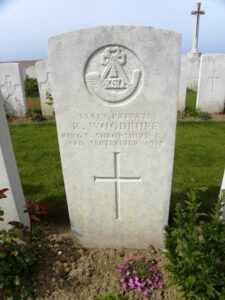The 3rd Battalion, King’s Shropshire Light Infantry was stationed at Bush Camp, Pembroke Dock, at the outbreak of war, and after a short period in Ireland, returned to the town from March 1915 until December 1917. The 9th Battalion, KSLI was formed here in September 1914, eventually becoming a Reserve Battalion. The 3rd KSLI was also a reserve battalion, used for training new recruits, to enable the supply of trained reinforcements to other KSLI Battalions at the Front. By 1918 the 4th (Reserve) Battalion, KSLI was also stationed at Pembroke Dock, as the Milford Haven Garrison. Due to the Regiments strong ties with the town, St. John’s Church at Pembroke Dock holds eight oak memorial panels, which are located on the north side of the Lady Chapel, to commemorate the fallen members of the KSLI who trained at Bush Camp. There is also a small memorial plaque in St. Mary’s Church, Pembroke, which commemorates the KSLI. (Below)
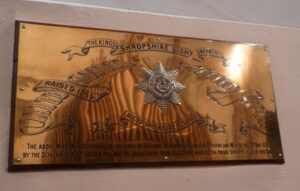
The St. John’s Church Memorial contains the names of the fallen, listed by year, beneath the following inscription:
‘To the Glory of God and in Memory of their Comrades especially those who were confirmed by the Bishop of this Diocese, this screen is dedicated by the Officers and men of the King’s Shropshire Light Infantry who went from Bush Camp in this Parish to the Great War 1914-1918’.
The Roll of Honour of the KSLI
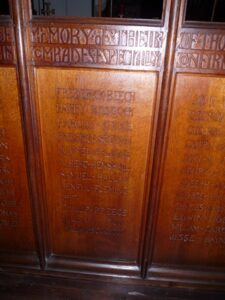
Colwell Anderson, Private, 32609, King’s Shropshire Light Infantry. Colwell was the son of Andrew and Martha Jane Anderson, of Overpool, Whitby, Birkenhead. He enlisted at Ellesmere Port into the King’s Shropshire Light Infantry, and after training at Pembroke Dock, was posted to their 8th Battalion, which was attached to 66 Brigade, 22nd Division. The Division landed in France on 5 September 1915, and then sailed from Marseilles on 28 October for Salonika, where it remained for the rest of the war. Colwell was killed in Salonika on 18 September 1918. He was 36 years old, and is commemorated on the Doiran Memorial, Salonika.
Frederick Beech, Private, 24078, King’s Shropshire Light Infantry. Frederick was the son of William and Martha Beech, of 8, Tong Norton, Shifnal, Salop. He had enlisted at Ironbridge into the King’s Shropshire Light Infantry, and trained at Pembroke Dock before being posted to their 5th Battalion, which was attached to 42 Brigade, 14th (Light) Division. On 20 May 1915 the Division landed at Boulogne, and saw its first major action at the Battle of Loos. In the Spring of 1916, the Division was involved in German gas attacks near Hulluch, and in the defence of the Kink position. In July it moved to the Somme, where they took part in the Battle of Pozieres, and then fought at Battle of Flers-Courcelette, where they captured Martinpuich. Frederick was killed on the Somme on 16 September 1916. He was just 18 years old, and is commemorated on the Thiepval Memorial, France.
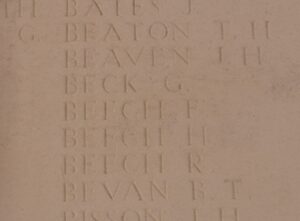
George Bloomfield, Private, 26048, King’s Shropshire Light Infantry. George was the son of John and Annie Bloomfield, of Bishop’s Prome, Worcs, and the husband of Edith James (formerly Bloomfield), of Pippin Hill, Acton Beauchamp, Worcester. He had enlisted at Leominster into the King’s Shropshire Light Infantry, and trained at Pembroke Dock before being posted to their 1st Battalion, which was attached to 16 Brigade, 6th Division, which had been in France since 10 September 1914. After participating in most of the major battles of the war, in 1918 the Division took part in the 100 days offensive, and in the Battle of the St. Quentin Canal. George was wounded during this action, and died on 26 September 1918, aged 31. He is buried at Brie British Cemetery, France.
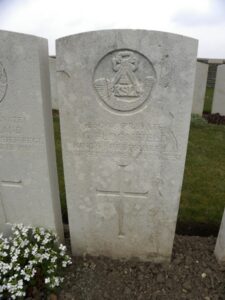
Harry Bostock, Private, 24225, King’s Shropshire Light Infantry. Harry was born at Nantwich, and enlisted at Crewe into the King’s Shropshire Light Infantry. After training at Pembroke Dock, he was posted to their 5th Battalion, which was attached to 42 Brigade, 14th (Light) Division. On 20 May 1915 the Division landed at Boulogne, and saw its first major action at the Battle of Loos. In the Spring of 1916, the Division was involved in German gas attacks near Hulluch, and in the defence of the Kink position. In July it moved to the Somme, where they took part in the Battle of Pozieres, and then fought at Battle of Flers-Courcelette, where they captured Martinpuich. Harry was killed on the Somme on 16 September 1916, and is commemorated on the Thiepval Memorial, France.

Samuel Bower, Private, 33749, King’s Shropshire Light Infantry. Samuel was born at New Brighton, Merseyside, and enlisted at Wallasey into the King’s Shropshire Light Infantry. After serving at Pembroke Dock, he was posted to their 10th Battalion, which was attached to 231 Brigade, 74th (Yeomanry) Division, which moved to France from Palestine on 7 May 1918, landing at Marseilles. Although already vastly experienced, the Division was initiated into the trench warfare of the Western Front in Flanders after arrival. Samuel was killed there on 22 August 1918, and is buried at Merville Communal Cemetery Extension, France.
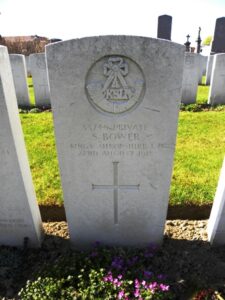
Harry Boycott, Private, 17392, King’s Shropshire Light Infantry. Harry was the son of Elizabeth Ann Adamson, and lived with her and his stepfather William Adamson at 39, Coalmore, nr Horsehay. He had enlisted in the King’s Shropshire Light Infantry at Wellington in February 1915, a week after his 18th birthday, and after training at Pembroke Dock was posted to their 5th Battalion, which was attached to 42 Brigade, 14th (Light) Division. On 20 May 1915 the Division landed at Boulogne, and saw its first major action at the Battle of Loos. Harry died before this however. He was wounded in the head on 2 August, after only being in France for four weeks. His battalion at the time was holding trenches in the vicinity of Hooge and Railway Wood in the Ypres salient. Harry succumbed to his wounds three days later, on 5 August 1915, aged 18. Harry is buried at Etaples Military Cemetery, France.
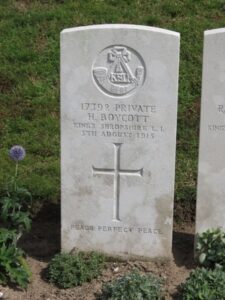
Thomas Nathan Brassington, Private, 28612, North Staffordshire Regiment. Thomas was the son of Nathan and Agnes Brassington, of Heathton Cottages, Claverley, Wolverhampton, and lived at Shifnal, Salop before the war. He originally enlisted at Shrewsbury into the King’s Shropshire Light Infantry, with the service number 19279, and after training at Pembroke Dock was posted to the 1st Battalion, North Staffordshire Regiment, which had been in France since August 1914. By the time Thomas joined the battalion, sometime in 1916, it had been transferred to 72 Brigade, 24th Division. He would have fought with the Division on the Somme in 1916, then at Arras the following year. The Division then moved to positions north of St. Quentin over the winter of 1917/18, and were here when the Germans launched their Offensive on 21 March, 1918, fighting a famous defence of the village of Le Verguier. Thomas was killed here on 21 March 1918. He was 22 years old, and is commemorated on the Pozieres Memorial, France.
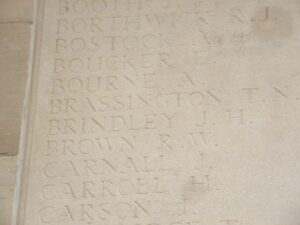
Ernest Breeze, Private, 33080, King’s Shropshire Light Infantry. Ernest was born at Hope Bowdler, Salop, the son of William and Hannah Maria Breeze. He lived at Dry Hill, All Stretton, Salop with his wife Mary Ann Breeze, and their children prior to the war, and enlisted at Church Stretton into the King’s Shropshire Light Infantry. After training at Pembroke Dock, he was posted to their 6th Battalion, which was attached to 60 Brigade, 20th (Light) Division, and moved to France on 22 July 1915. The Division first moved to the Fleurbaix Sector for trench familiarisation and training. When the Battle of Loos was launched on 25 September 1915 the Division fought a diversionary attack towards Fromelles. Later that year they moved north, and fought at the Battle of Mount Sorrel alongside the Canadian Corps. They then fought through the Somme Offensive, at the Battles of Delville Wood, Guillemont, Flers-Courcelette, Morval and Le Transloy, and took part in the advance to the Hindenburg Line in March, 1917. Later that year they fought at Third Ypres. Ernest was killed during the Battle of the Menin Road on 23 September 1917, aged 34. He is buried at Poelcapelle British Cemetery, Belgium.
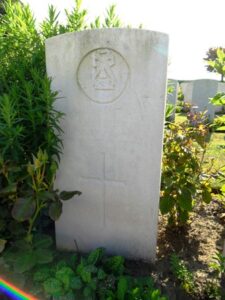
John Brick, Private, 34387, King’s Shropshire Light Infantry. John was the son of John and Anne Brick, of Newhouse, Llanbister, Penybont Station, Radnor. He enlisted at Knighton into the King’s Shropshire Light Infantry, and after training at Pembroke Dock was posted to their 1st Battalion, which was attached to 16 Brigade, 6th Division, which had been in France since 10 September 1914. After participating in most of the major battles of the war, in 1918 the Division took part in the advance in Flanders, before moving to the Somme sector. John was killed in Flanders before this move south, on 14 August 1918. He was 19 years old, and is buried at Esquelbecq Military Cemetery, France.
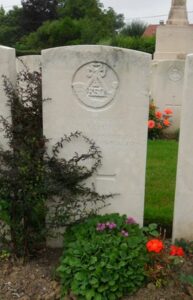
George Brinsley, Private, 27786, Royal Warwickshire Regiment. George was the son of Cornelius and Harriet Brinsley, of 327, New Bridge Lane, Stockport. He enlisted at Stockport into the King’s Shropshire Light Infantry, with the number 22332, and after training at Pembroke Dock was posted to the 11th Battalion, Royal Warwickshire Regiment, which was attached to 112 Brigade, 37th Division. The Division moved to France in July 1915, and saw its first major action during the Attack on the Gommecourt Salient, during the first phase of the Battle of the Somme. Two of the Division’s infantry Brigades (111th and 112th), and the Divisional pioneers were attached to the 34th Division (that had suffered very heavy losses in the attack on La Boiselle in the opening phase of the Somme battle) between 6 July and 22 August 1916. They took part in a number of actions while attached. Upon their return, the 37th Division fought at the Battle of the Ancre. They then moved in March 1917 and took part in the First Battle of the Scarpe, where they captured Monchy le Preux. They then took part in the Second Battle of the Scarpe, and the Battle of Arleux. George was wounded at Arras, and died on 29 April 1917, aged 29. He is commemorated on the Arras Memorial, France.
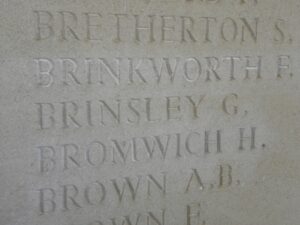
William George Percival Brown, Private, 33481, King’s Shropshire Light Infantry. William was born on 22 July 1892, the son of John Percy Brown and Mary Emma Brown, of 17, Edge Lane, Liverpool. He enlisted there into the King’s Shropshire Light Infantry. After training at Pembroke Dock he was posted to their 6th Battalion, which was attached to 60 Brigade, 20th (Light) Division, and moved to France on 22 July 1915. The Division first moved to the Fleurbaix Sector for trench familiarisation and training. When the Battle of Loos was launched on 25 September 1915 the Division fought a diversionary attack towards Fromelles. Later that year they moved north, and fought at the Battle of Mount Sorrel alongside the Canadian Corps. They then fought through the Somme Offensive, at the Battles of Delville Wood, Guillemont, Flers-Courcelette, Morval and Le Transloy, and took part in the advance to the Hindenburg Line in March, 1917. Later that year they fought at Third Ypres, before moving to take part in the Battle of Cambrai. William was killed at Cambrai on 25 November 1917, aged 25. He has no known grave, and is commemorated on the Cambrai Memorial, Louverval, France.
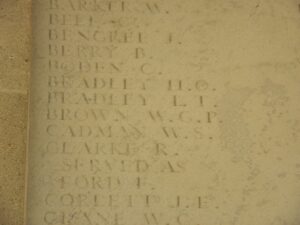
Charles Edward Burgwin, Private, 56476, Royal Welsh Fusiliers. Charles was the son of Jeremiah and Mary Ann Burgwin, of Wheat Sheaf Passage, Frankwell, Shrewsbury. He enlisted there into the King’s Shropshire Light Infantry, with the service number 25625. After training at Pembroke Dock, he was posted to the 16th Battalion, Royal Welsh Fusiliers, which was attached to 113 Brigade, 38th (Welsh) Division, probably joining the battalion as a reinforcement after its mauling at Mametz Wood in July 1916. He moved with the battalion to positions along the Yser Canal at Boesinghe, and was wounded during the Battle of Pilckem Ridge. Charles died of his wounds on 5 August 1917, aged 34. Charles is buried at Dozinghem Military Cemetery, Belgium.
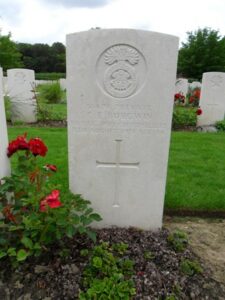
William Carter, Lance Corporal, 19401, King’s Shropshire Light Infantry. William was the son of Andrew and Alice Carter, of 29, High Street, Much Wenlock, Salop. He enlisted at Shrewsbury into the King’s Shropshire Light Infantry, and after training at Pembroke Dock was posted to their 6th Battalion, which was attached to 60 Brigade, 20th (Light) Division, and moved to France on 22 July 1915. The Division first moved to the Fleurbaix Sector for trench familiarisation and training. When the Battle of Loos was launched on 25 September 1915 the Division fought a diversionary attack towards Fromelles. Later that year they moved north, and fought at the Battle of Mount Sorrel alongside the Canadian Corps. They then fought through the Somme Offensive, at the Battles of Delville Wood, Guillemont, Flers-Courcelette, Morval and Le Transloy, and took part in the advance to the Hindenburg Line in March, 1917. Later that year they fought at Third Ypres. William was killed during the Battle of Langemarck on 16 August 1917. He was 26 years old, and is commemorated on the Tyne Cot Memorial, Belgium.
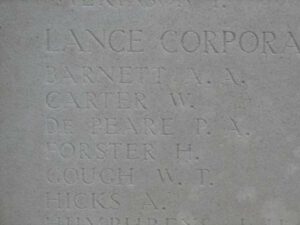
Ernest Cashion, Private, 26054, King’s Shropshire Light Infantry. Ernest was the son of John William and Elizabeth Cashion, of Tenbury, Worcester. The family later moved to Shrewsbury, where Ernest married Ellen Jackson at Shrewsbury in 1914, and the couple briefly resided at 2, Carline Terrace, Coleham Head, Shrewsbury. Ernest enlisted at Shrewsbury into the King’s Shropshire Light Infantry, and after training at Pembroke Dock was posted to their 6th Battalion, which was attached to 60 Brigade, 20th (Light) Division, and moved to France on 22 July 1915. The Division first moved to the Fleurbaix Sector for trench familiarisation and training. When the Battle of Loos was launched on 25 September 1915 the Division fought a diversionary attack towards Fromelles. Later that year they moved north, and fought at the Battle of Mount Sorrel alongside the Canadian Corps. They then fought through the Somme Offensive, at the Battles of Delville Wood, Guillemont, Flers-Courcelette, Morval and Le Transloy, and took part in the advance to the Hindenburg Line in March, 1917. Later that year they fought at Third Ypres. Ernest was wounded during the Battle of Langemarck, and died on 20 August 1917, aged 37. He is buried at Mendinghem Military Cemetery, Belgium.
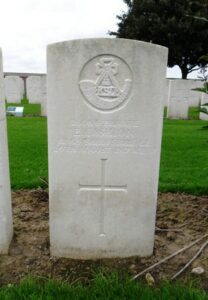
William Henry Coombes, Pioneer, 130308, Royal Engineers. William was the son of Henry and Elizabeth Coombes, of Marnwood Lodge, 35 Buildwas Road, Ironbridge, Shropshire. He resided at Coalbrookdale prior to the war, and enlisted at Ironbridge into the King’s Shropshire Light Infantry, with the service number 19280. After training at Pembroke Dock, he was posted to No. 1 Special Brigade, Royal Engineers, which was a specialist Chemical Warfare company, which was tasked with the use of poisonous gas. William was killed during the build up to the launching of the Battle of the Somme, on 25 June 1916, aged 21. He is buried at Sucrerie Military Cemetery, Colincamps, France.
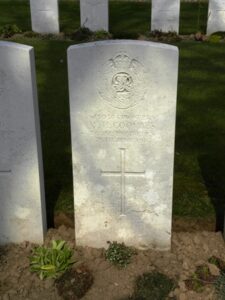
William Edward Cornes, Private, 25510, King’s Shropshire Light Infantry. William was the son of William Edward and Ann Cornes, The Lloyds, Ironbridge. He enlisted at Ironbridge into the King’s Shropshire Light Infantry. After training at Pembroke Dock, he was posted to their 5th Battalion, which was attached to 42 Brigade, 14th (Light) Division. On 20 May 1915 the Division landed at Boulogne, and saw its first major action at the Battle of Loos. In the Spring of 1916, the Division was involved in German gas attacks near Hulluch, and in the defence of the Kink position. In July it moved to the Somme, where they took part in the Battle of Pozieres, and then fought at Battle of Flers-Courcelette, where they captured Martinpuich. The Division followed the German retreat to the Hindenburg Line the following year, and it was during this period that William was wounded. He died on 11 March 1917, aged 19, and is buried at Trois Arbres Cemetery, Steenwerck, France.
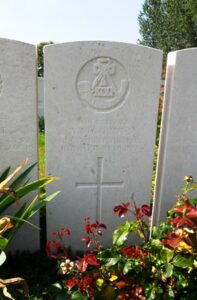
Joseph Henry Cotton, Private, 15324, Prince of Wales’s Leinster Regiment (Royal Canadians). Joseph was the son of Thomas Cotton, of 12 Waterloo, Whixall, Whitchurch, Salop. He originally enlisted into the King’s Shropshire Light Infantry, with the service number 32206, and after training at Pembroke Dock was posted to the 7th Battalion, Leinster Regiment, which was attached to 47 Brigade, 16th (Irish) Division. The Division moved to France in December 1915, and concentrated in the Bethune area. They saw their first major action during the Somme Offensive, at the Battle of Guillemont, and also fought at the Battle of Ginchy. By May, 1917 the Division had moved to positions south of Ypres, where they fought at the Battle of Messines, and then moved north, fighting at the Battle of Langemarck. Joseph was killed there on 2 August 1917. He was 18 years old, and is buried at Tyne Cot Cemetery, Belgium.
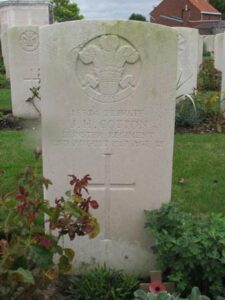
Walter Crowther, Private, 32406, King’s Shropshire Light Infantry. Walter was born at Cheapside, Manchester, and enlisted there into the King’s Shropshire Light Infantry. After training at Pembroke Dock, he was posted to their 6th Battalion, which was attached to 60 Brigade, 20th (Light) Division, and moved to France on 22 July 1915. The Division first moved to the Fleurbaix Sector for trench familiarisation and training. When the Battle of Loos was launched on 25 September 1915 the Division fought a diversionary attack towards Fromelles. Later that year they moved north, and fought at the Battle of Mount Sorrel alongside the Canadian Corps. They then fought through the Somme Offensive, at the Battles of Delville Wood, Guillemont, Flers-Courcelette, Morval and Le Transloy, and took part in the advance to the Hindenburg Line in March, 1917. Later that year they fought at Third Ypres, before moving to take part in the Battle of Cambrai. Walter was killed at Cambrai on 30 November 1917. He has no known grave, and is commemorated on the Cambrai Memorial, Louverval, France.
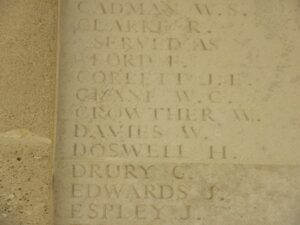
Robert Daniels, Lance Corporal, G/21408, Queen’s Own (Royal West Kent Regiment). Robert was the son of Thomas and Margaret Daniels, of 75, Overbury Street, Edge Hill, Liverpool. He enlisted at Liverpool into the King’s Shropshire Light Infantry, with the service number 33544, and after training at Pembroke Dock was posted to the 7th Battalion, Royal West Kent Regiment. The battalion moved to France in July 1915 attached to 55 Brigade, 18th (Eastern) Division, and saw its first major action during the Battle of the Somme in the summer of 1916. During 1917 the Division fought at the Battles of Arras and Passchendaele, and on 21 March 1918 was stationed on the Somme, where it was hit by the German Spring Offensive. They fought at the Battle of St Quentin, and suffered terrible casualties, and then took part in the Battle of the Avre and the Actions of Villers-Bretonneux. On 8 August 1918 they formed part of the force which attacked the German positions around Villers Brettoneux, south of the Somme Valley, during the Battle of Amiens, and then took part in the Battle of Albert, which began the great push by the Allies which ended the war. Robert was killed on 2 September 1918, aged 24. He has no known grave, and is commemorated on the Vis-En-Artois Memorial, France.
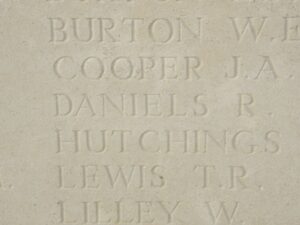
Edward Reginald Davies, Private, 16823, King’s Shropshire Light Infantry. Edward was the son of Samuel and Mary Davies, of 15, Raven Lane, Ludlow, Salop. He enlisted at Ludlow into the King’s Shropshire Light Infantry, and after training at Pembroke Dock was posted to their 1/4th Battalion, which had moved to France from the Far East in July 1917. The Battalion joined 190 Brigade, 63rd (Royal Naval) Division, and fought with the Division at the Battle of Passchendaele. On 4 February 1918 the 1/4th KSLI transferred to 56 Brigade, 19th (Western) Division. In 1918 they were caught up in the German Spring Offensive near St. Quentin, where they suffered terrible casualties, and fought at the Battle of Bapaume. They moved to Ypres, but were caught up in the German attack at Messines, and at Bailleul, and Kemmel. After suffering terribly again, they moved South to the quieter French sector to rebuild, but were caught up in the German offensive on the Aisne, and the KSLI gained fame for their gallant defence of Mont de Bligny. Edward was killed on the Aisne on 23 July 1918. He was 36 years old, and is buried at St. Souplet British Cemetery, France. Edward is shown on the memorial as having fallen in 1917.
Stanley Edmund Davies, Private, 24712, King’s Shropshire Light Infantry. Stanley was the son of the late James Davies, and of Mrs. Yapp, of 32, New Street, Leominster, Herefordshire. He enlisted at Ludlow into the King’s Shropshire Light Infantry, and after training at Pembroke Dock was posted to their 6th Battalion, which was attached to 60 Brigade, 20th (Light) Division, which moved to France in July 1915, fighting a diversionary attack towards Fromelles in September. Later that year the Division moved north, and fought at the Battle of Mount Sorrel alongside the Canadian Corps. They then fought through the Somme Offensive, at the Battles of Delville Wood, Guillemont, Flers-Courcelette, Morval and Le Transloy, and took part in the advance to the Hindenburg Line in March 1917. Later that year they fought at Third Ypres, at the Battles of Langemarck, the Menin Road, and Polygon Wood, before moving south in November, to take part in the Battle of Cambrai. They remained in the area between Cambrai and St. Quentin over the winter of 1917/18 and were attacked there by the German Spring Offensive of 21 March 1918. Stanley was killed on 28 March 1918, during the desperate fighting which followed. He was 20 years old, and is commemorated on the Pozières Memorial, France.
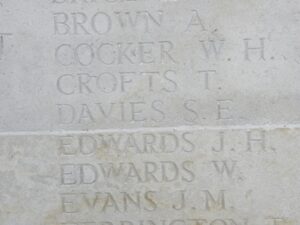
Gordon Drury, Private, 24114, King’s Shropshire Light Infantry. Gordon was born in 1897, the son of Edward and Elizabeth Drury, of 18, Charlotte Row, Ellesmere, Salop. He enlisted there into the King’s Shropshire Light Infantry, and trained at Pembroke Dock before being posted to their 1st Battalion, which was in France attached to 16 Brigade, 6th Division. Gordon probably joined the battalion after the Somme Battles of 1916, and would have seen his first action during the Battle of Arras. Later that year the Division took part in the Battle of Cambrai, and it was here that Gordon was killed on 4 December 1917. He was 20 years old, and is commemorated on the Cambrai Memorial, Louverval, France.
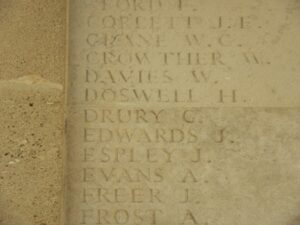
James Evans, Private, 26013, King’s Shropshire Light Infantry. James was the son of Charles and Emma Evans, of 5, Diglake, Tilstock, Whitchurch, Salop. He enlisted at Whitchurch into the King’s Shropshire Light Infantry, and after training at Pembroke Dock was posted to their 6th Battalion, which was attached to 60 Brigade, 20th (Light) Division, which moved to France in July 1915, fighting a diversionary attack towards Fromelles in September. Later that year the Division moved north, and fought at the Battle of Mount Sorrel alongside the Canadian Corps. They then fought through the Somme Offensive, at the Battles of Delville Wood, Guillemont, Flers-Courcelette, Morval and Le Transloy, and took part in the advance to the Hindenburg Line in March 1917. Later that year they fought at Third Ypres, and James was seriously wounded during the Battle of Langemarck. He died of his wounds on 17 August 1917, aged 30, and is buried at Dozinghem Military Cemetery, Belgium.
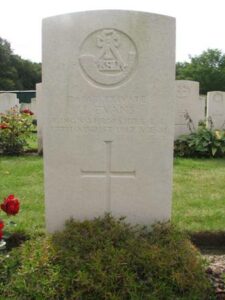
Thomas Evans, Private, 44346, King’s Shropshire Light Infantry. Thomas was born in 1898, the son of John Evans and Sarah Evans (nee Robinson), of Cwm Colsty, Clun. By 1911 the family had moved to Lane House Farm, Whitcott, Clun. Thomas enlisted into the King’s Shropshire Light Infantry early in 1918 and was posted to Pembroke Dock to join the 4th (Reserve) Battalion, King’s Shropshire Light Infantry. Thomas took ill whilst training at Pembroke and was taken to Pembroke Dock Military Hospital, where he died on 6 July 1918. The remains of the 21-year-old were taken back home to Shropshire and he was buried in St. john the Evangelist Churchyard, Newcastle.
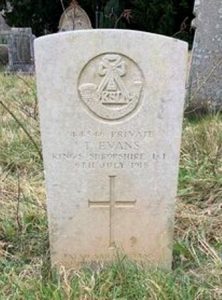
Henry John Fleming, Private, 15412, King’s Shropshire Light Infantry. Henry was the son of William and Fanny Fleming, of 19, Meeson, Great Bolas, Wellington, Salop. He enlisted at Wellington into the King’s Shropshire Light Infantry. After training at Pembroke Dock, he was posted to their 7th Battalion, which was attached to 76 Brigade, 25th Division, before joining the 3rd Division in France in October 1915. In 1915 the Division saw action at Bellewaarde and Hooge, and took part in the Second attack on Bellewaarde, and in 1916 fought at the Actions of the Bluff, and at the St Eloi Craters. They were then moved south to the Somme, where they were to take part in the great Battle of the Somme, and fought there at the Battle of Albert, and at the Battle of Bazentin, where they captured Longueval. They then took part in the Battle of Delville Wood, and the Battle of the Ancre, before settling into another bleak winter in France. Henry was wounded on the Somme, and returned to Britain for treatment. He died of wounds at Cardiff Hospital on 19 December 1916, aged 21 and is buried at Wellington General Cemetery, Shropshire.
William Fletcher, Private, 19073, King’s Shropshire Light Infantry. William was the son of Edward and Emma Fletcher, of 265, Waxall Houses, Donnington Wood, Newport, Salop. He enlisted at Wellington into the King’s Shropshire Light Infantry, and after training at Pembroke Dock was posted to their 5th Battalion, which was attached to 42 Brigade, 14th (Light) Division. The Division moved to France in May 1915, and saw its first action during the Action of Hooge, where the Division were the first to be attacked by the German use of flamethrowers. They then fought at the Second attack on Bellewaarde. In July, 1916 they moved to the Somme, and fought at the Battle of Delville Wood. William was wounded here, and evacuated to the Military Hospital at Amiens. He died of his wounds on 28 August 1916, aged 24, and is buried at St. Pierre Cemetery, Amiens, France.
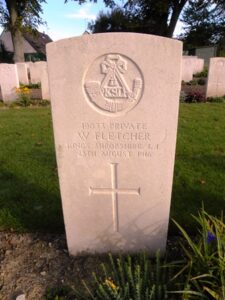
William Addison Fox, Private, 25402, King’s Shropshire Light Infantry. William was the son of William and Sarah Fox, of 35, Glass House Row, Wrockwardine Wood, Wellington, Salop. He enlisted at Wellington into the King’s Shropshire Light Infantry, and after training at Pembroke Dock was posted to their 8th Battalion, which was attached to 66 Brigade, 22nd Division. The Division moved to France in September 1915, and the following month sailed for Salonika. It remained in the theatre for the rest of the war, taking part in the Retreat from Serbia during December, 1915. During 1916 the Division fought in two major battles, at the battle of Horseshoe Hill, then at the battle of Machukovo. William was wounded early in 1917, and died of his wounds on 27 February 1917. He was 19 years old, and is buried at Karasouli Military Cemetery, Salonika.
Thomas Francis, Private, 18035, King’s Shropshire Light Infantry. Thomas was the son of Thomas and Susannah Francis, of The Tally Ho, Boulden, Diddlebury, Craven Arms, Salop. He enlisted at Shrewsbury into the King’s Shropshire Light Infantry, and after training at Pembroke Dock was posted to their 7th Battalion, which was attached to 76 Brigade, 25th Division, before joining the 3rd Division in France in October 1915. In 1915 the Division saw action at Bellewaarde and Hooge, and took part in the Second attack on Bellewaarde, and in 1916 fought at the Actions of the Bluff, and at the St Eloi Craters. Thomas was killed at St. Eloi on 3 April 1916. He was 23 years old, and is commemorated on the Ypres (Menin Gate) Memorial, Belgium. The memorial lists him among the 1918 casualties.
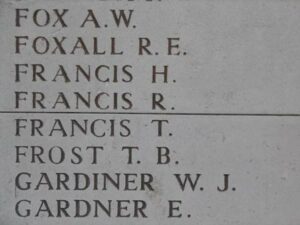
Lewis James Gilbert, Private, 15330, Prince of Wales’s Leinster Regiment (Royal Canadians). Lewis was the son of Lewis and Annie Gilbert, of The Vern, Bodenham, Herefordshire. He initially enlisted into the King’s Shropshire Light Infantry at Hereford, with the service number 32883, before being posted to the 2nd Battalion, Leinster Regiment, after his training at Pembroke Dock. The battalion was attached to 88 Brigade, 29th Division early in 1918, after previous service with the 6th, 24th and 16th Divisions. The German Spring Offensive hit the British on the Somme on 21 March, 1918, and hit in Flanders just weeks later. The 29th Division fought at the desperate defensive battles of Estaires, Messines, Bailleul and Kemmel, before the war turned in favour of the Allies after a series of successes on the Somme in August. The Division then took part in the Offensive in Flanders, where they took part in the Action of Outtersteene Ridge. Lewis was wounded during the resulting advance, and died on 5 September 1918 as a result. He was 20 years old, and is buried at La Kreule Military Cemetery, Hazebrouck, France.
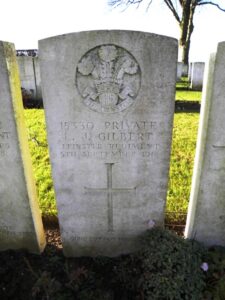
Herbert Goostrey, Private, 51675, Cheshire Regiment. Herbert was born in 1897, the son of William Henry and Charlotte Goostrey, of 33, Shaw Road, Stockport. He worked as a Railway Engine Cleaner prior to the war. He enlisted at Stockport on 11 December 1915 into the King’s Shropshire Light Infantry, with the service number 33719, and after training at Pembroke Dock was posted to the 16th Battalion, Cheshire Regiment, moving to France in October 1917. On 6 February 1918 the battalion was disbanded, and Herbert was posted to the 12th Entrenching Battalion. Within weeks, the Germans launched their last ditch offensive on the Somme, and the Entrenching Battalion was thrown into a desperate defensive action. Herbert was killed in action on 23 March 1918, aged 20. He has no known grave, and is commemorated on the Pozieres Memorial, France.
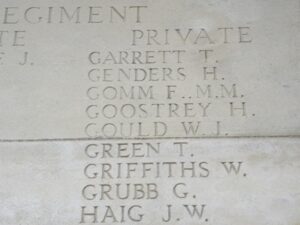
James Horrocks Gorrell, Private, 25450, King’s Shropshire Light Infantry. James was the son of Robert and Mercy Gorrell, of 7, Alice Street, Oswaldtwistle, Lancashire. He enlisted at Accrington into the army, and was posted to the King’s Shropshire Light Infantry. After training at Pembroke Dock, James was posted to Egypt, and joined the 10th Battalion, King’s Shropshire Light Infantry. The battalion was formed at Cairo on 2 March 1917, and was attached to 231 Brigade, 74th (Yeomanry) Division. The division then took part in the offensive into Palestine. James was killed in Palestine during the Third Battle of Gaza, on 28 December 1917, aged 27. He is commemorated on the Jerusalem Memorial, Israel.
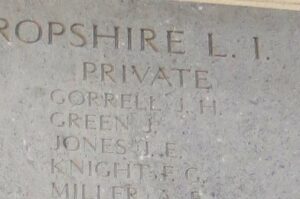
James Herbert Green, Private, 33148, King’s Shropshire Light Infantry. James was the son of George and Mary Ann Green, of Maryvale Cottage, Lower Mill Street, Ludlow, Salop. He enlisted at Ludlow into the King’s Shropshire Light Infantry, and was posted to Bush Camp. After completing his training, James was confirmed at St. John’s Church, Pembroke Dock on 23 April 1917 prior to leaving for France, and received his first Communion at St. Alban’s Church, Bush Camp. James joined the 6th Battalion, King’s Shropshire Light Infantry in France in May 1917. The battalion was attached to 60 Brigade, 20th (Light) Division. The 20th Division were readying for the forthcoming Third Battle of Ypres, and moved into positions near Boesinghe on 6 August 1917, relieving the 38th Welsh Division. On 16 August 1917 the 6th KSLI attacked Langemarck, crossing the Steenbeek that morning on their way to the assembly points. James was killed during the attack of 16 August 1917, aged 19. His body was lost in the mud of the battlefield, and he is commemorated on the Tyne Cot Memorial, Belgium. Many thanks to Monica Green for identifying her Uncle James.
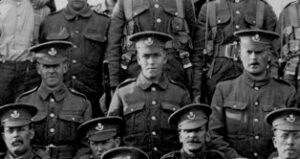
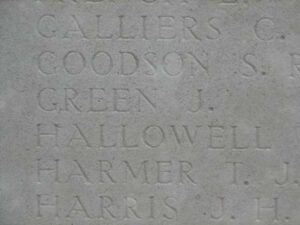
Harold Grice, Private, 19027, King’s Shropshire Light Infantry. Harold was the son of James and Annie Grice, of Pascalls Buildings, Priorslee, Salop. He enlisted at Wellington into the King’s Shropshire Light Infantry, and after training at Pembroke Dock was posted to their 7th Battalion, which was attached to 76 Brigade, 25th Division, before joining the 3rd Division in France in October 1915. In 1915 the Division saw action at Bellewaarde and Hooge, and took part in the Second attack on Bellewaarde, and in 1916 fought at the Actions of the Bluff, and at the St Eloi Craters. They were then moved south to the Somme, where they were to take part in the great Battle of the Somme, and fought there at the Battle of Albert, and at the Battle of Bazentin, where they captured Longueval. They then took part in the Battle of Delville Wood. Harold was killed here on 18 August 1916, aged 19. He is commemorated on the Thiepval Memorial, France.
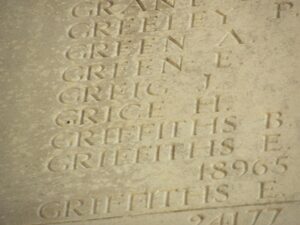
Harry Grimshaw, Private, 32502, King’s Shropshire Light Infantry. Harry was born on 1 March 1897, the son of John and Grace Grimshaw, of 10, Earl Street, Burnley, Lancashire, and enlisted there into the King’s Shropshire Light Infantry. After training at Pembroke Dock, he was posted to their 8th Battalion, which was attached to 66 Brigade, 22nd Division. The Division moved to France in September 1915, and the following month sailed for Salonika. It remained in the theatre for the rest of the war, taking part in the Retreat from Serbia during December, 1915. During 1916 the Division fought in two major battles, at the battle of Horseshoe Hill, then at the battle of Machukovo. In 1917 the Division fought at the two Battles of Doiran, and it was during the Second Battle of Doiran, on 31 August 1917, that Harry was killed in action. He was 20 years old, and is buried at Doiran Military Cemetery, Salonika.
David Haddon, Private, 18321, King’s Shropshire Light Infantry. David was the son of Frederick William and Bessie Haddon, of New Street, Oakengates, Salop. He enlisted at Stratford-on-Avon into the King’s Shropshire Light Infantry, and after training at Pembroke Dock was posted to their 1st Battalion, which was in France attached to 16 Brigade, 6th Division. David saw his first action at Ypres, and was killed there on 3 May 1916. He was 24 years old, and is buried at Essex Farm Cemetery, Belgium.
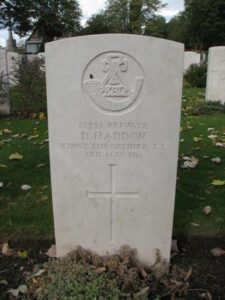
Samuel Hallam, Private, 23980, King’s Shropshire Light Infantry. Samuel was the son of Thomas and Alice Hallam, of 319, High Street, West Glossop, Derbyshire. He enlisted at Glossop into the King’s Shropshire Light Infantry, and after training at Pembroke Dock was posted to their 7th Battalion, which was attached to 76 Brigade, 25th Division, before joining the 3rd Division in France in October 1915. In 1915 the Division saw action at Bellewaarde and Hooge, and took part in the Second attack on Bellewaarde, and in 1916 fought at the Actions of the Bluff, and at the St Eloi Craters. They were then moved south to the Somme, where they were to take part in the great Battle of the Somme, and fought there at the Battle of Albert, and at the Battle of Bazentin, where they captured Longueval. They then took part in the Battle of Delville Wood. Samuel was wounded during later fighting on the Somme, and died of his wounds on 21 November 1916. He was 21 years old, and is buried at Etaples Military Cemetery, France.
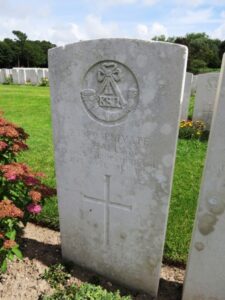
George Haynes, Private, 37285, Lancashire Fusiliers. George was born at Northwood, Ellesmere, Salop, and enlisted at Oswestry into the King’s Shropshire Light Infantry, with the service number 23539. After training at Pembroke Dock, he was posted to the 11th Battalion, Lancashire Fusiliers, which was attached to 74 Brigade, 25th Division. The Division landed in France in September 1915, and was posted to Vimy, where they defended Vimy Ridge against a German attack in May 1916. It moved to the Somme, and attacked on 3 July near Thiepval, fighting throughout the Battle of the Somme, before moving to Ploegsteert, where they held the line for the months leading up the Battle of Messines in June 1917. After fighting at Messines, the Division moved north, and fought at Pilckem, before moving south again, where they took up positions around Bullecourt in reserve. Here the Division was used to reinforce the badly depleted British units that were hit in the area by the German Spring Offensive. They moved north to Flanders on the night of 30 March, where they took up positions at Ploegsteert again, where they received reinforcements, and rebuilt. However, on 9 April the Germans launched an offensive on the Lys, and the Division was caught up in the terrible fighting here, at the Battles of Estaires, Bailleul, Messines and Kemmel. The Division withdrew to Abeele on 17 April, but George was killed on 20 April 1918. He is buried at Croix-Du-Bac British Cemetery, Steenwerck, France. His grave is marked by Special Memorial B3, as the exact location of his grave has been lost.
Jesse Haynes, Private, 32926, King’s Shropshire Light Infantry. Jesse was born at Church Stretton, Salop, the son of Thomas and Annie Haynes. Thomas died in 1916, and Annie remarried, moving to 43, New Hall View, Brynfields, Ruabon, Wrexham. Jesse enlisted at Church Stretton into the King’s Shropshire Light Infantry, and after training at Pembroke Dock was posted to their 6th Battalion, which was attached to 60 Brigade, 20th (Light) Division. The Division moved to France in July 1915, its first action being a diversionary attack towards Fromelles in September. Later that year the Division moved north, and fought at the Battle of Mount Sorrel alongside the Canadian Corps. They then fought through the Somme Offensive, at the Battles of Delville Wood, Guillemont, Flers-Courcelette, Morval and Le Transloy, and took part in the advance to the Hindenburg Line in March 1917. Later that year they fought at Third Ypres, and Jesse was killed in action during the Battle of Langemarck on 16 August 1917. He was just 16 years old, and is commemorated on the Tyne Cot Memorial, Belgium.
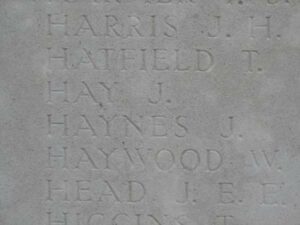
Albert Henshall, Private, 27784, Royal Warwickshire Regiment. Albert was the son of Harriet Henshall, of 42, Yardington Street, Whitchurch, Salop. He enlisted at Whitchurch into the King’s Shropshire Light Infantry, and after training at Pembroke Dock was posted to the 11th Battalion, Royal Warwickshire Regiment, which was attached to 112 Brigade, 37th Division. The Division landed in France in August 1915. They took part in the Attack on the Gommecourt Salient, during the first phase of the Battle of the Somme. Two of the Division’s infantry Brigades (111 and 112), and the Divisional pioneers were attached to the 34th Division, due to their heavy losses in the attack on La Boiselle in the opening phase of the Somme battle. Upon their return, the Division fought at the Battle of the Ancre. Albert was killed on the Ancre on 14 November 1916. He was 23 years old, and is commemorated on the Thiepval Memorial, France.
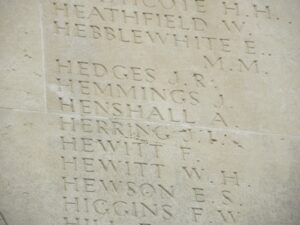
Edwin Jesse Herbert, Private, 19468, King’s Shropshire Light Infantry. Edwin was the son of Richard and Alice Herbert of Ledgemore, Weobley, Herefordshire. He enlisted at Shrewsbury into the King’s Shropshire Light Infantry, and after training at Pembroke Dock was posted to their 7th Battalion, which was attached to 76 Brigade, 25th Division, before joining the 3rd Division in France in October 1915. In 1915 the Division saw action at Bellewaarde and Hooge, and took part in the Second attack on Bellewaarde, and in 1916 fought at the Actions of the Bluff, and at the St Eloi Craters. They were then moved south to the Somme, where they were to take part in the great Battle of the Somme, and fought there at the Battle of Albert, and at the Battle of Bazentin, where they captured Longueval. They then took part in the Battle of Delville Wood, and this is where Edwin was killed on 18 August 1916. He was 36 years old, and is commemorated on the Thiepval Memorial, France.
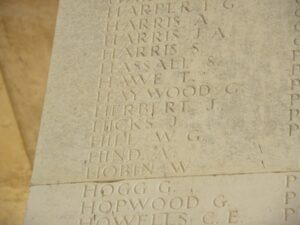
Henry John Hewer, Private, 24771, King’s Shropshire Light Infantry. Henry was the son of Henry and Hannah Hewer, of Compton Cottage, Newent, Glos. He had moved away from home prior to 1901, and his next of kin was his sister, Mrs. Clara Ellen Bowkett, of Pool Hill, Newent, Glos. Henry enlisted at Hereford into the King’s Shropshire Light Infantry, and after training at Pembroke was posted to France in 1916, joining the 1st Battalion, King’s Shropshire Light Infantry. The battalion was on the Somme attached to 16 Brigade, 6th Division. Henry would have fought throughout the Somme offensive that year, before the division moved to positions north of Arras. He was wounded during the summer of 1917 and evacuated to Bethune, where he died on 7 July 1917, aged 35. Henry is buried at Bethune Town Cemetery, France.
John William Higgins, Private, 24113, King’s Shropshire Light Infantry. John was the son of Thomas and Alice Higgins, of Moathouse Cottages, Wem, Salop. He enlisted at Wem into the King’s Shropshire Light Infantry, and after training at Pembroke Dock was posted to their 7th Battalion, which was attached to 76 Brigade, 25th Division, before joining the 3rd Division in France in October 1915. In 1915 the Division saw action at Bellewaarde and Hooge, and took part in the Second attack on Bellewaarde, and in 1916 fought at the Actions of the Bluff, and at the St Eloi Craters. They were then moved south to the Somme, where they were to take part in the great Battle of the Somme, and fought there at the Battle of Albert, and at the Battle of Bazentin, where they captured Longueval. They then took part in the Battle of Delville Wood. The Division then moved to Arras, and John was killed at Arras on 9 April 1917. He was 20 years old, and is buried at Tilloy British Cemetery, Tilloy-Les-Mofflaines, France.
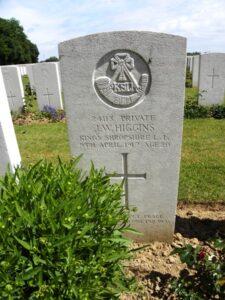
Albert J. Johnson, Private, 28100, King’s Shropshire Light Infantry. Albert was born at Preston, and enlisted at Bolton into the Training Reserve Battalion, with the service number 4/32064. After training at Pembroke Dock, he was posted to the 6th Battalion, King’s Shropshire Light Infantry, which was attached to 60 Brigade, 20th (Light) Division. The Division moved to France in July 1915, fighting a diversionary attack towards Fromelles in September. Later that year the Division moved north, and fought at the Battle of Mount Sorrel alongside the Canadian Corps. They then fought through the Somme Offensive, at the Battles of Delville Wood, Guillemont, Flers-Courcelette, Morval and Le Transloy, and took part in the advance to the Hindenburg Line in March 1917. Later that year they fought at Third Ypres, before moving south in November, to take part in the Battle of Cambrai. They remained in the area between Cambrai and St. Quentin over the winter of 1917/18 and were attacked there by the German Spring Offensive of 21 March 1918. They then fought in the retreat at the Battle of the Somme Crossings and the Battle of Rosieres. The Division was withdrawn after the heavy fighting of the Somme battles, moving on 20 April 1918 to an area south west of Amiens. Albert died here on 14 July 1918, and is buried at Sucrerie Cemetery, Ablain-St. Nazaire, France.
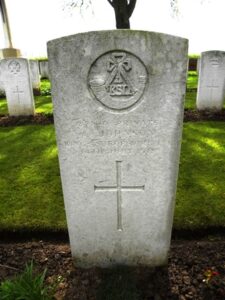
John William Johnson, Private, 25614, King’s Shropshire Light Infantry. John was born on 4 October 1875, the son of Arthur and Caroline Johnson, of Birmingham. He married Eva Mary Ann Thomas around 1902, and the couple resided at Malmesbury, Wiltshire prior to moving to Gable Cottages, Alton Street, Ross, Herefordshire. John enlisted at Ross into the King’s Shropshire Light Infantry, and after training at Pembroke Dock was posted to their 7th Battalion, which was attached to 76 Brigade, 25th Division, before joining the 3rd Division in France in October 1915. In 1915 the Division saw action at Bellewaarde and Hooge, and took part in the Second attack on Bellewaarde, and in 1916 fought at the Actions of the Bluff, and at the St Eloi Craters. They were then moved south to the Somme, where they were to take part in the great Battle of the Somme, and fought there at the Battle of Albert, and at the Battle of Bazentin, where they captured Longueval. They then took part in the Battle of Delville Wood, and the Battle of the Ancre, before settling into another bleak winter in France. In May, 1917 the Division were at Arras, and fought at the First and Second Battles of the Scarpe, and at the Battle of Arleux and the Third Battle of the Scarpe, where they captured Roeux. John was killed at Arras on 15 May 1917, aged 43. He is buried at Duisans British Cemetery, Etrun, France.
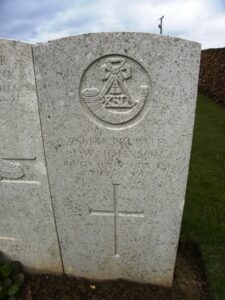
John Stanley Joseph, Private, 44314, King’s Shropshire Light Infantry. John was the son of John and Annie Joseph, of Willey, Presteigne. He worked on his fathers farm prior to the war but was conscripted in 1916 and sent to join the 4th Battalion, King’s Shropshire Light Infantry at Pembroke Dock. He was confirmed on 14 July 1918 by the Bishop of St Davids at St Albans Church, Bush Camp, Pembroke Dock, but within months had taken ill and was sent home. John died of influenza and meningitis at Lower House, Presteigne on 19 November 1918. He was buried in the family plot at Lingen (St. Michael) Churchyard, Herefordshire. He is not commemorated by the CWGC.
John William Kelly, Private, 22418, King’s Shropshire Light Infantry. John was born in 1897, the son of Joseph and Jane Kelly, of 13, Listley Street, Bridgnorth, Salop. He enlisted at Newport into the King’s Shropshire Light Infantry, and after training at Pembroke Dock was posted to their 7th Battalion, which was attached to 76 Brigade, 25th Division, before joining the 3rd Division in France in October 1915. In 1915 the Division saw action at Bellewaarde and Hooge, and took part in the Second attack on Bellewaarde, and in 1916 fought at the Actions of the Bluff, and at the St Eloi Craters. They were then moved south to the Somme, where they were to take part in the great Battle of the Somme, and fought there at the Battle of Albert, and at the Battle of Bazentin, where they captured Longueval. They then took part in the Battle of Delville Wood, and the Battle of the Ancre, before settling into another bleak winter in France. In May, 1917 the Division were at Arras, and fought at the First and Second Battles of the Scarpe, and at the Battle of Arleux and the Third Battle of the Scarpe, where they captured Rouex. They fought at Ypres later that year, and in 1918 were caught up in the German Spring Offensive on the Somme. John was probably captured around March or April 1918, and taken to a Prisoner of War Camp in Germany. He died in captivity on 23 July 1918, aged 21. John is buried at Hamburg War Cemetery, Germany.
George Kniveton, Private, 23962, King’s Shropshire Light Infantry. George was the son of Charles and Sophia Kniveton, of 17, Grafton Street, Stockport, Cheshire. He enlisted there into the King’s Shropshire Light Infantry, and after training at Pembroke Dock was posted to their 7th Battalion, which was attached to 76 Brigade, 25th Division, before joining the 3rd Division in France in October 1915. In 1915 the Division saw action at Bellewaarde and Hooge, and took part in the Second attack on Bellewaarde, and in 1916 fought at the Actions of the Bluff, and at the St Eloi Craters. They were then moved south to the Somme, where they were to take part in the great Battle of the Somme, and fought there at the Battle of Albert, and at the Battle of Bazentin, where they captured Longueval. They then took part in the Battle of Delville Wood, and the Battle of the Ancre, before settling into another bleak winter in France. In May, 1917 the Division were at Arras, and fought at the First Battle of the Scarpe. George was killed here on 26 April 1917, aged 21. He has no known grave, and is commemorated on the Arras Memorial, France.
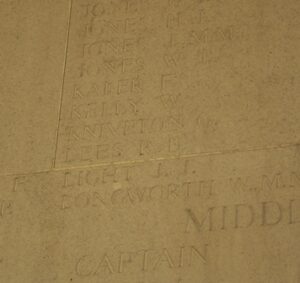
John William Langford, Private, 25404, King’s Shropshire Light Infantry. John was the only son of Albert and Mary Langford, of 10, Finger Road, Dawley, Shropshire. John was a China Decorator at the Coalport China works. He enlisted at Ironbridge into the King’s Shropshire Light Infantry, and after training at Pembroke Dock was posted to their 6th Battalion, which was attached to 60 Brigade, 20th (Light) Division, and moved to France on 22 July 1915. The Division first moved to the Fleurbaix Sector for trench familiarisation and training. When the Battle of Loos was launched on 25 September 1915 the Division fought a diversionary attack towards Fromelles. Later that year they moved north, and fought at the Battle of Mount Sorrel alongside the Canadian Corps. They then fought through the Somme Offensive, at the Battles of Delville Wood, Guillemont, and Flers-Courcelette, and took part in the advance to the Hindenburg Line in March, 1917. Later that year they fought at Third Ypres; at the Battles of Langemarck, the Menin Road, and Polygon Wood, before moving south in November, to take part in the Battle of Cambrai. On 30 November 1917, John was with his battalion in reserve when at 06.30 a German barrage started to fall on the British Trenches on the Gonnelieu- St Quentin ridge. The barrage had spread to other positions by 07.30 and this was followed by a German infantry attack in thick fog of between 8 to 12 waves, this forced the British back to the North and south east slopes of Welsh Ridge. At 09.00 the 6th KSLI moved forward to the Ridge in two waves, the Germans had advanced on their right, and the men were met with German Machine-Gun fire. John was killed that day, on 30 November 1917, aged 31. He is buried at Fifteen Ravine British Cemetery, Villers-Plouich, France.
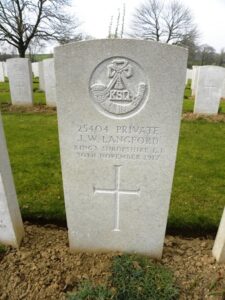
John Thomas Latham, Private, 34861, King’s Shropshire Light Infantry. John was the son of Ernest and Ann Latham, of Donington Wood, Salop. He enlisted at Wellington into the King’s Shropshire Light Infantry. After training at Pembroke Dock, he was posted to their 7th Battalion, which was attached to 76 Brigade, 25th Division. The Division moved to France in September 1915, with the 7th KSLI being transferred to the 3rd Division within weeks of arrival. The battalion saw its first action at the Hohenzollern redoubt, at Loos. In 1916 the Division moved south to the Somme, where they fought during the opening of the Somme Offensive at the Battle of Albert, then at Bazentin, Pozieres, Flers-Courcelette and Morval. It then moved to the Arras Sector for a while, before taking part in the Battles of Passchendaele and Cambrai later that year. The Division was caught up in the German Offensive on the Somme in March 1918, and after suffering heavily moved to Flanders to rest. However they were caught up in a fresh offensive on the Lys in April 1918. The Division then took part in the great offensive from 21 August 1918 onwards, and John was killed during the Second Battle of Bapaume on 2 September 1918, aged 38. He has no known grave, and is commemorated on the Vis-En-Artois Memorial, France.
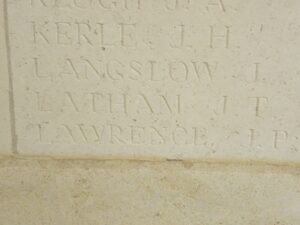
George Edward Lawley, Private, 28633, North Staffordshire Regiment. George was born on 23 February 1898, the son of Richard and Ellen Lawley, of 7, Woundale, Bridgnorth, Salop. He enlisted on 22 March 1916 at Bridgnorth into the King’s Shropshire Light Infantry, with the service number 17139, and after training at Pembroke Dock was posted to the 1st Battalion, North Staffordshire Regiment, which was attached to 17 Brigade, 6th Division, and moved to France in September 1914. The Division fought on the Aisne, then at Hooge, near Ypres. In October 1915 the 1st North Staffs transferred to 72 Brigade, 24th Division at Loos. The Division moved to the Somme sector in 1916, and fought at Delville Wood and Guillemont. George was killed near Guillemont on 31 August 1916, aged 18. He is commemorated on the Thiepval Memorial, France. The memorial lists him as being among the fallen of 1917, but that is incorrect.
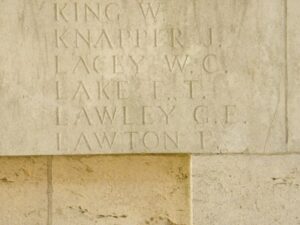
Victor Leaver, Private, 24083, King’s Shropshire Light Infantry. Victor was born in 1895, the son of Francis and Eleanor Leaver, of Sleight Cottage, Pottern, Wiltshire. He enlisted at Bridgnorth into the King’s Shropshire Light Infantry, and after training at Pembroke Dock was posted to their 7th Battalion, which was attached to 76 Brigade, 25th Division. The Division moved to France in September 1915, with the 7th KSLI being transferred to the 3rd Division within weeks of arrival. The battalion saw its first action at the Hohenzollern redoubt, at Loos. In 1916 the Division moved south to the Somme, where they fought during the opening of the Somme Offensive at the Battle of Albert, then at Bazentin Ridge and at Pozieres. Victor was wounded at Pozieres, and died in Hospital on 22 August 1916. He was 20 years old, and is buried at Abbeville Communal Cemetery, France.
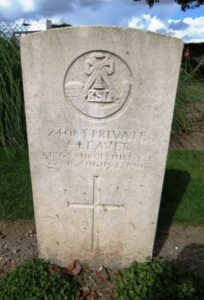
Albert Lewis, Private, 33172, King’s Shropshire Light Infantry. Albert was born around 1883, and resided with his wife Mary Lewis at 27, New Park Street, Castlefields, Shrewsbury. He enlisted at Shrewsbury on 12 December 1915 into the 3rd Battalion, King’s Shropshire Light Infantry. Albert was mobilised on 15 March 1917, and served on home service at Pembroke Dock until 14 November 1917, when he was discharged as medically unfit, after being hospitalised at Pembroke Dock for several weeks. It seems that Albert was not of the best of health before enlisting, but his poor health was aggravated by the strains of military service, and Albert was hospitalised at the Royal Salop Infirmary on 1 May 1919. He died at the Royal Salop Infirmary on 8 May 1919, aged 35. Nothing further is presently known of him, except that the memorial incorrectly shows that he fell in 1918.
Cecil Ernald Lines, Private, 116089, Machine Gun Corps. Cecil was born in 1890, the son of William and Harriet Lines, of 4, Pickard Street, Warwick. By 1911 he was living with his wife Lucy Anne Lines at 2, Providence Row, Drickwater Street, Shrewsbury. Cecil enlisted at Shrewsbury into the King’s Shropshire Light Infantry, with the service number 34473, and after training at Pembroke Dock was posted to the 26th Company, Machine Gun Corps, which was attached to the 12th Division. The Division landed at Boulogne in May 1915, and took over the line at Ploegsteert Wood. They then moved south and fought in the Battle of Loos, and remained there until March 1916. By June they were in position at the Somme, and attacked Ovillers on 2 July. They fought at Pozieres and Le Transloy before being moved to the Arras area during October, 1916, where they fought in the March 1917 Battle of Arras, taking part in the First Battle of the Scarpe, and the Battle of Arleux. They then fought at the Third Battle of the Scarpe, and helped capture Roeux. The Division remained at Arras until taking part in the Battle of Cambrai in November, 1917. They were relieved at the beginning of December, and moved to positions near Albert to rest. Cecil was killed near Bapaume on 9 January 1918. He was 27 years old, and is buried at Fins New British Cemetery, Sorel-Le-Grand, France.
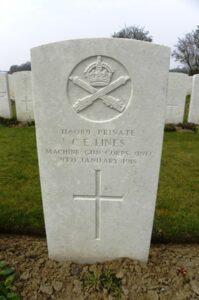
Richard Thomas Lloyd, Private, 11417, King’s Shropshire Light Infantry. Richard was the son of Richard and Elizabeth Lloyd, of 3, Canal View, Crickheath, Oswestry. He enlisted at Shrewsbury into the King’s Shropshire Light Infantry, and after training at Pembroke Dock was posted to their 5th Battalion, which was attached to 42 Brigade, 14th (Light) Division. On 20 May 1915 the Division landed at Boulogne, and saw its first major action at the Battle of Loos. In the Spring of 1916, the Division was involved in German gas attacks near Hulluch, and in the defence of the Kink position. In July it moved to the Somme, where they took part in the Battle of Pozieres, and then fought at Battle of Flers-Courcelette, where they captured Martinpuich. In March 1917 the Division followed the German Retreat to the Hindenburg Line, and in May took part in the Battles of the Scarpe. They then moved to Ypres, where they fought at the Battle of Langemarck, the First Battle of Passchendaele and the Second Battle of Passchendaele. Richard was wounded during the final stages of the Battle, and died at a Casualty Clearing Station on 23 October 1917. He was 30 years old, and is buried at Godewaersvelde British Cemetery, Belgium.
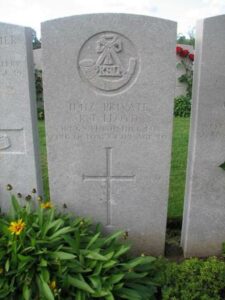
Arthur Gerald Longmate, Private, 18314, King’s Shropshire Light Infantry. Arthur was the son of Gerald and Jane Longmate, of Hill View, Sutton-on-Trent, Newark, Notts. He enlisted at Shrewsbury into the King’s Shropshire Light Infantry, and after training at Pembroke Dock was posted to their 5th Battalion, which was attached to 42 Brigade, 14th (Light) Division. On 20 May 1915 the Division landed at Boulogne, and saw its first major action at the Battle of Loos. In the Spring of 1916, the Division was involved in German gas attacks near Hulluch, and in the defence of the Kink position. Arthur was killed on 10 February 1916. He was 30 years old, and is commemorated on the Ypres (Menin Gate) Memorial, Belgium.
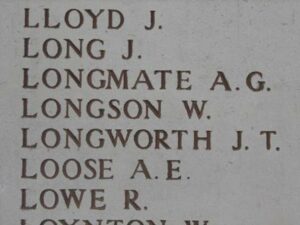
Alfred Howard Lowe, Private, 23767, King’s Shropshire Light Infantry. Alfred was son of Reuben and Elizabeth Lowe, of Shifnal, Salop, and the Brother-in-law of Edith M. Lowe, of 2, High Street, Shifnal, Salop. He enlisted into the King’s Shropshire Light Infantry, and after training at Pembroke Dock was posted to their 7th Battalion, which was attached to 76 Brigade, 25th Division. The Division moved to France in September 1915, with the 7th KSLI being transferred to the 3rd Division within weeks of arrival. The battalion saw its first action at the Hohenzollern redoubt, at Loos. In 1916 the Division moved south to the Somme, where they fought during the opening of the Somme Offensive at the Battle of Albert, then at Bazentin Ridge and at Pozieres. Alfred was killed on the Somme on 31 October 1916. He was 29 years old, and is buried at Courcelles-Au-Bois Communal Cemetery Extension, France.
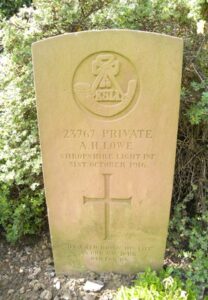
Percy Mackenzie, Private, 24350, King’s Shropshire Light Infantry. Percy was the son of James and Annie MacKenzie, of 58, High Street, Cheadle, Manchester, and the husband of Hilda Daisy MacKenzie, of Chapel Larle, Wilmslow, Manchester. He enlisted at Wilmslow into the King’s Shropshire Light Infantry, and after training at Pembroke Dock was posted to their 7th Battalion, which was attached to 76 Brigade, 25th Division. The Division moved to France in September 1915, with the 7th KSLI being transferred to the 3rd Division within weeks of arrival. The battalion saw its first action at the Hohenzollern redoubt, at Loos. In 1916 the Division moved south to the Somme, where they fought during the opening of the Somme Offensive at the Battle of Albert, then at Bazentin Ridge and at Pozieres. Percy was killed at Pozieres on 18 August 1916. He was 24 years old, and is buried at Flatiron Copse Cemetery, Mametz, France.
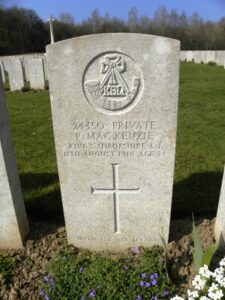
James Maney, Private, 51714, Cheshire Regiment. James was the son of Joseph and Mary Eleanor Maney, of 40, Wakefield Road, Stalybridge, Cheshire. He enlisted at Hyde into the King’s Shropshire Light Infantry, with the service number 33741. After training at Pembroke Dock, James landed in France in October 1917, and was posted to the 16th Battalion, Cheshire Regiment. The Battalion was disbanded in France in February 1918, and James was posted to the 12th Entrenching Battalion. He was killed in action during the German Spring Offensive on 22 March 1918, aged 19, and is commemorated on the Pozières Memorial, France.
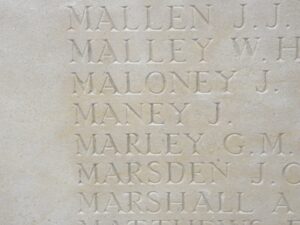
Harry McDougall, Private, 125954, Machine Gun Corps. Harry was the son of Henry and Mary McDougall, of 31, Tub Street, Denton, Lancashire. He originally enlisted at Hyde into the King’s Shropshire Light Infantry, with the service number 34646. After training at Pembroke Dock, Harry was posted to the 59th Battalion, Machine Gun Corps, which was in France attached to the 59th Division. The Division landed in France in February 1917, and took part in the German Retreat to the Hindenburg Line, before moving to Ypres later that year. Here, they fought at the Battle of the Menin Road and the Battle of Polygon Wood, during the Third Battle of Ypres. In November the Division moved south, and took part in the Battle of Cambrai. It was still in the area by March 1918 when the Germans launched their Offensive on the Somme, and the Division was caught up in the desperate fighting at the Battle of St Quentin. Harry was killed during the initial attack on 21 March 1918. He was 30 years old, and is commemorated on the Arras Memorial, France.
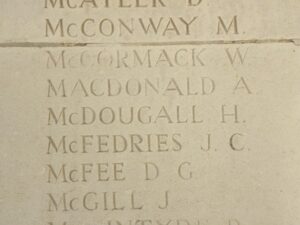
Lionel John Morley, Private, 22456, King’s Shropshire Light Infantry. Lionel was the son of John Howell Morley and Mary Jane Morley, of 431, White Cross Road, Hereford. He enlisted at Hereford into the King’s Shropshire Light Infantry, and after training at Pembroke Dock was posted to their 1st Battalion, which was in France attached to 16 Brigade, 6th Division. They took part in the Action of Hooge during June 1915, and in 1916 moved to the Somme, where the Division fought at the Battle of Flers-Courcelette, the Battle of Morval and the Battle of Le Transloy. Lionel was killed on the Somme on 8 September 1916. He was 26 years old, and is buried at Caterpillar Valley Cemetery, Longueval, France.
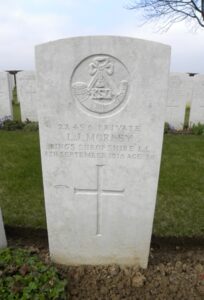
Edwin Noble, Private, 40061, South Wales Borderers. Edwin was the son of Alice Noble, of 24, Manchester Road, Tintwistle, Manchester. He enlisted at Glossop into the King’s Shropshire Light Infantry, with the service number 23979. After training at Pembroke Dock, Edwin was posted to the 2nd Battalion, South Wales Borderers. The Battalion had served in China and Gallipoli, before moving to France, attached to 87 Brigade, 29th Division. The Division took part in its first major action in France during the 1916 Somme Offensive, and fought at the Battles of Albert and Le Transloy, suffering heavy casualties. In the Spring of 1917 they fought at the Battle of the Scarpe, which was part of the Arras Offensive, and then moved further north to Ypres. Here they took part in the Battle of Langemarck, and Edwin was wounded on the first day of the battle, on 16 August 1917, dying later that day of his wounds. He was 20 years old, and is buried at Bleuet Farm Cemetery, Belgium.
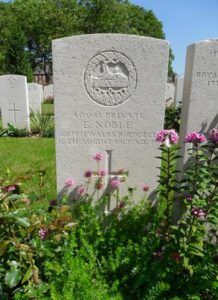
James Norris, Private, 34606, King’s Shropshire Light Infantry. James was the Husband of Sarah Annie Norris, of The Row, Pentewan, St. Austell, Cornwall. He enlisted at Ashton-Under-Lyne into the King’s Shropshire Light Infantry, and after training at Pembroke Dock was posted to their 1/4th Battalion, which was a Territorial unit that had seen service in the Far East, before returning to France in 1917, where it initially joined 190 Brigade, 63rd (Royal Naval) Division. After fighting at Passchendaele, the battalion transferred to 56 Brigade, 19th (Western) Division, and was decimated by the German offensive on the Lys in April 1918. The battered Division was sent to the Aisne to rebuild, but was hit by a fresh offensive there, with the 1/4th KSLI gaining renown during the defence of Mont de Bligny, the battalion being awarded the French Croix-de-Guerre. The Division then took part in the great offensive which was to win the war, but James was wounded during the advance, and died of his wounds in Hospital at Rouen on 8 November 1918. James was 37 years old, and is buried at St. Sever Cemetery Extension, Rouen, France.
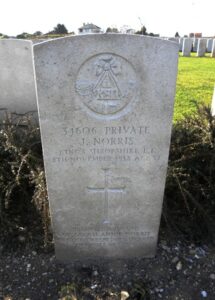
Charles Ogden, Private, 32138, King’s Shropshire Light Infantry. Charles was the son of William and Hannah Ogden, and the Husband of Ada Ogden, of 103, Water Street, Nelson, Lancs. He enlisted there into the King’s Shropshire Light Infantry, and after training at Pembroke Dock was posted to their 6th Battalion, which was attached to 60 Brigade, 20th (Light) Division, and moved to France on 22 July 1915. The Division first moved to the Fleurbaix Sector for trench familiarisation and training. When the Battle of Loos was launched on 25 September 1915 the Division fought a diversionary attack towards Fromelles. Later that year they moved north, and fought at the Battle of Mount Sorrel alongside the Canadian Corps. They then fought through the Somme Offensive, at the Battles of Delville Wood, Guillemont, and Flers-Courcelette, and took part in the advance to the Hindenburg Line in March, 1917. Later that year they fought at Third Ypres; at the Battles of Langemarck. Charles was killed while the battalion was in the line on 12 September 1917. He was 32 years old, and is buried at Talana Farm Cemetery, Belgium.
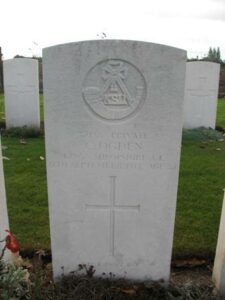
Charles Herbert Oliver, Private, 33248, King’s Shropshire Light Infantry. Charles was the son of Thomas J. and Emma Oliver, of Mocktree, Leintwardine, Herefordshire. He enlisted there into the King’s Shropshire Light Infantry, and after training at Pembroke Dock was posted to their 10th Battalion, which was attached to 231 Brigade, 74th (Yeomanry) Division. The Division had formed in Egypt in January 1917 and had fought through the Palestinian Campaign, at the Battles of Gaza and the Battle and capture of Jerusalem. Due to the terrible casualties suffered by the British on the Western Front in March and April 1918 the Division was recalled to the Western Front, and arrived at Marseilles during May 1918. They then fought at the Second Battle of Bapaume during the great offensive, and fought in Flanders before returning to the Somme and fighting at the Battle of Epehy. Charles was wounded on the Somme, and died on 4 September 1918. He was 20 years old, and is buried at Peronne Road Cemetery, Maricourt, France.
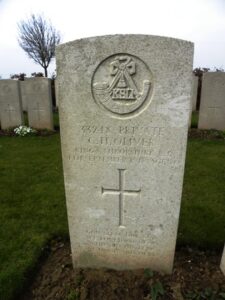
Edward Henry Owen, Private, 33256, King’s Shropshire Light Infantry. Edward was the son of Edward and Louisa Owen, of St. Mary’s Place, Welshpool. He enlisted there into the King’s Shropshire Light Infantry, and after training at Pembroke Dock was posted to their 10th Battalion, which was attached to 231 Brigade, 74th (Yeomanry) Division. The Division had formed in Egypt in January 1917 and had fought through the Palestinian Campaign, at the Battles of Gaza and the Battle and capture of Jerusalem. Due to the terrible casualties suffered by the British on the Western Front in March and April 1918 the Division was recalled to the Western Front, and arrived at Marseilles during May 1918. They then fought at the Second Battle of Bapaume during the great offensive, and fought in Flanders before returning to the Somme and fighting at the Battle of Epehy. Edward was killed during the assault on Gillemont Farm on 18 September 1918. He was 26 years old, and is commemorated on the Vis-en-Artois Memorial, France.
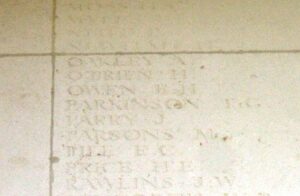
Philip Preece, Private, 19606, King’s Shropshire Light Infantry. Philip was the son of George and Laura Preece, of Red Ball, Stiperstones, Minsterley, Salop. He enlisted at Welshpool into the King’s Shropshire Light Infantry, and after training at Pembroke Dock was posted to their 7th Battalion, which was attached to 76 Brigade, 25th Division. The Division moved to France in September 1915, with the 7th KSLI being transferred to the 3rd Division within weeks of arrival. The battalion saw its first action at the Hohenzollern redoubt, at Loos. In 1916 the Division moved south to the Somme, where they fought during the opening of the Somme Offensive at the Battle of Albert, then at Bazentin Ridge and at Pozieres. They then took part in the Battle of Delville Wood, and the Battle of the Ancre, before settling into another bleak winter in France. Philip died at 37 Casualty Clearing Station, France of broncho-pneumonia on 22 February 1917. He was 19 years old, and is buried at Avesnes-Le-Comte Communal Cemetery Extension, France.
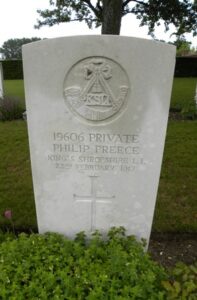
George Harris Pryce, Private, 237155, King’s Shropshire Light Infantry. George was the son of Thomas Harris Pryce and Mary Elizabeth Pryce, of Bettws y Crywn, Salop. He enlisted at Knighton into the King’s Shropshire Light Infantry, and after training at Pembroke Dock was posted to their 7th Battalion, which was attached to 76 Brigade, 25th Division. The Division moved to France in September 1915, with the 7th KSLI being transferred to the 3rd Division within weeks of arrival. The battalion saw its first action at the Hohenzollern redoubt, at Loos. In 1916 the Division moved south to the Somme, where they fought during the opening of the Somme Offensive at the Battle of Albert, then at Bazentin Ridge and at Pozieres. They then took part in the Battle of Delville Wood, and the Battle of the Ancre, before settling into another bleak winter in France. The Division fought at Arras and Ypres in 1917, and saw action during the German Offensive of 1918. On 21 August 1918, the Division took part in the opening of the Battle of Albert. George was killed that day, aged 32, and is buried at Bucquoy Road Cemetery, Ficheux, France.
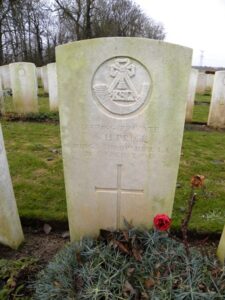
Clarence John Reynolds, Private, 126500, Machine Gun Corps. Clarence was born in Shrewsbury in 1891, the son of John and Mary Jane Reynolds, of Derwen Cottage, Meole Brace. He married Amelia Griffiths at Merthyr in 1913, and enlisted at Merthyr into the King’s Shropshire Light Infantry, with the service number 37415. After training at Pembroke Dock, Clarence was posted to the 51st Battalion, Machine Gun Corps, which was attached to the 51st (Highland) Division. The Division had won itself a fierce reputation during the war, after taking part in most of the major battles after landing in France in 1915. In May 1918 the Division was at Oppy, near Arras, where it remained until 11 July. Clarence was killed at Oppy on 8 July 1918. He was 26 years old, and is buried at Anzin-St. Aubin British Cemetery, France.
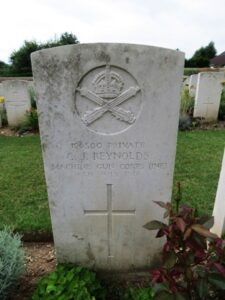
John Richards, Private, 31869, King’s Shropshire Light Infantry. John was born on 14 November 1892, the son of John and Susannah Richards, of 49, Castle Street, Coseley, Staffs. He was a Police Constable at Leek, Staffs before the war, and originally enlisted into the Military Foot Police at Leek, with the service number P/2668. John was then transferred into the King’s Shropshire Light Infantry, and after training at Pembroke Dock was posted to their 10th Battalion, which was attached to 231 Brigade, 74th (Yeomanry) Division. The Division had formed in Egypt in January 1917 and had fought through the Palestinian Campaign, at the Battles of Gaza and the Battle and capture of Jerusalem. Due to the terrible casualties suffered by the British on the Western Front in March and April 1918 the Division was recalled to the Western Front, and arrived at Marseilles during May 1918. The Division moved to positions in Flanders upon arrival. John was killed in Flanders on 22 August 1918. He was 26 years old, and is buried at Vieille-Chappelle New Military Cemetery, Lacoutre, France.
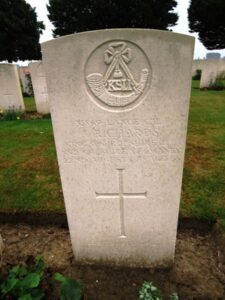
William H. Richards, King’s Shropshire Light Infantry. William is recorded on the Memorial as having fallen in 1918. He cannot be positively identified.
Jeffrey John Rider, Private, 33492, King’s Shropshire Light Infantry. Jeffrey was the son of Jeffrey and Margaret Rider, of 71, Troughton Street, Edge Hill, Liverpool. He enlisted at Liverpool into the King’s Shropshire Light Infantry, and after training at Pembroke Dock was posted to their 7th Battalion, which was attached to 76 Brigade, 25th Division. The Battalion moved to France in September 1915, transferring to the 3rd Division. William probably joined the Battalion after its part in the Somme Battles. In May, 1917 the Division were at Arras, and fought at the First and Second Battles of the Scarpe, and at the Battle of Arleux and the Third Battle of the Scarpe, where they captured Roeux. Again they moved, this time back to Ypres, where they fought in the Third Battle of Ypres, at the Battle of the Menin Road and the Battle of Polygon Wood. In November the Division moved south again, where they fought at the Battle of Cambrai, and they were in the area during March, 1918 when the German Spring Offensive swept through the British lines. Jeffrey was killed during the ensuing fighting on 28 March 1918. He was 19 years old, and is commemorated on the Arras Memorial, France.
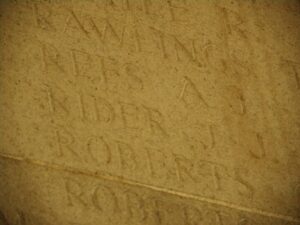
William Rimmer, Private, 51708, Cheshire Regiment. William was the son of James and Mary Rimmer, of Upper Brighton, Cheshire. He married Lizzie Mary Maria Elson on 7 August 1915, and the couple resided at 5, Tower Buildings, Upper Brighton, Cheshire. William enlisted at Wallasey on 8 December 1915 into the King’s Shropshire Light Infantry, with the service number 33861, and after training at Pembroke Dock was posted to France on 19 October 1917, briefly joining the 5th Battalion, King’s Shropshire Light Infantry. On 23 October 1917 William was transferred to the 15th Battalion, Cheshire Regiment, which was attached to 105 Brigade, 35th Division. William fought at the Second Battle of Passchendaele. By the Spring of 1918 the Division was on the Somme, and fought at the First Battle of Bapaume, during the German Offensive. William was killed in action on the Somme on 17 May 1918, aged 23. He was originally buried by the road from Clery to Manancourt, but his grave was lost, and he is today commemorated on the Pozieres Memorial, France.
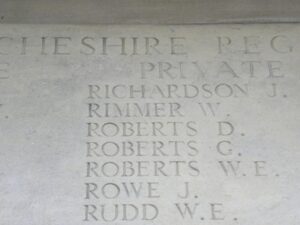
George Henry Roberts, Private, 34453, King’s Shropshire Light Infantry. George was the son of Edward and Linda Roberts, of Beaumute Tree Cottage, Howle Hill, Ross, Herefordshire. He enlisted at Hereford into the King’s Shropshire Light Infantry, and after training at Pembroke Dock was posted to their 1/4th Battalion. The Battalion had garrisoned Hong Kong and Singapore for the first two years of war, before embarking for France when it joined 190 Brigade, 63rd (Royal Naval) Division at Ypres in August 1917. The Division then took part in the Battle of Passchendaele. On 4 February 1918, the 4th KSLI transferred to 56 Brigade, 19th (Western) Division. In March 1918 they were caught up in the German Spring Offensive near St. Quentin, where they suffered terrible casualties, and fought at the Battle of Bapaume. They moved to Ypres, but were caught up in the German attack at Messines, and fought a gallant rearguard action towards Bailleul and Kemmel. After suffering terribly again, the 19th Division moved South to the quieter French sector to rebuild, but were caught up in the German offensive on the Aisne. George was killed on the Aisne on 7 June 1918. He was 24 years old, and is buried at Chambrecy British Cemetery, France.
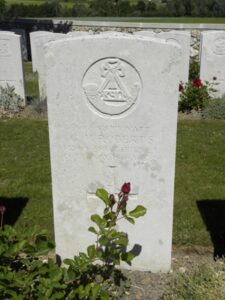
William George Roberts, Private, 35322, King’s Shropshire Light Infantry. William was the son of Sydney and Sarah Roberts, of Water Street, Neyland, Pembrokeshire. He enlisted at Honeyborough into the King’s Shropshire Light Infantry, and after training at Pembroke Dock was posted to their 7th Battalion, which was attached to 76 Brigade, 25th Division. The Battalion moved to France in September 1915, transferring to the 3rd Division. William probably joined the Battalion after its part in the Somme Battles. In May, 1917 the Division were at Arras, and fought at the First and Second Battles of the Scarpe, and at the Battle of Arleux and the Third Battle of the Scarpe, where they captured Roeux. Again they moved, this time back to Ypres, where they fought in the Third Battle of Ypres, at the Battle of the Menin Road and the Battle of Polygon Wood. In November the Division moved south again, where they fought at the Battle of Cambrai, and they were in the area during March, 1918 when the German Spring Offensive swept through the British lines. William was killed during the ensuing fighting on 22 March 1918. He was 19 years old, and is commemorated on the Arras Memorial, France.
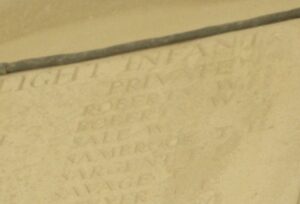
John James Sawyer, Private, 34248, King’s Shropshire Light Infantry. John was born at Clungunford, Salop, the son of Elizabeth Tyrrell, later of 22, Dinham, Ludlow, Salop. He enlisted at Ludlow into the King’s Shropshire Light Infantry, and after training at Pembroke Dock was posted to their 1/4th Battalion. The Battalion had garrisoned Hong Kong and Singapore for the first two years of war, before embarking for France when it joined 190 Brigade, 63rd (Royal Naval) Division at Ypres in August 1917. The Division then took part in the Battle of Passchendaele. On 4 February 1918, the 4th KSLI transferred to 56 Brigade, 19th (Western) Division. In March 1918 they were caught up in the German Spring Offensive near St. Quentin, where they suffered terrible casualties, and fought at the Battle of Bapaume. John was killed during the ensuing fighting, on 26 March 1918. He was 23 years old, and is commemorated on the Arras Memorial, France.
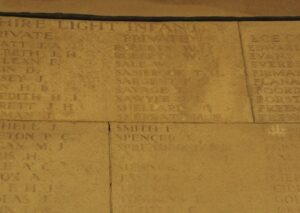
Joseph Nelmes Scudamore, Private, 25000, King’s Shropshire Light Infantry. Joseph was the son of Joseph and Julia Scudamore, of Harewood End, Ross, Herefordshire. He enlisted at Hereford into the King’s Shropshire Light Infantry, and after training at Pembroke Dock was posted to their 1st Battalion, which was in France attached to 16 Brigade, 6th Division, which landed in France in September 1914. Here they took part in the Action of Hooge during June 1915, and in 1916 moved to the Somme, where the Division fought at the Battle of Flers-Courcelette, the Battle of Morval and the Battle of Le Transloy. The following year saw them at Arras, where they fought at the Battle of Hill 70. Joseph was seriously wounded at Arras. He died of his wounds on 29 April 1917, aged 19, and is buried at Bethune Town Cemetery, France.
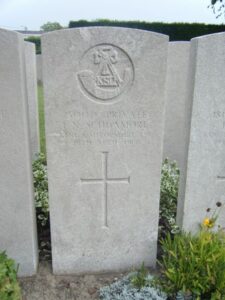
Percy Simmonds, Private, 25262, King’s Shropshire Light Infantry. Percy was the Nephew of Mrs. Brookfield, of 3, Mine Cottages, Clive, Grinshill, Shrewsbury. He enlisted at Wem into the King’s Shropshire Light Infantry, and after training at Pembroke Dock was posted to their 1st Battalion, which had been in France since September 1914, attached to 16 Brigade, 6th Division. Here they took part in the Action of Hooge during June 1915, and in 1916 moved to the Somme, where the Division fought at the Battle of Flers-Courcelette, the Battle of Morval and the Battle of Le Transloy. The following year saw them at Arras, where they fought at the Battle of Hill 70, and then during the Battle of Cambrai later in the year. The Division saw much action during the German Offensive of 1918, and in August took part in the Advance in Flanders. Percy was wounded during this period, and died of his wounds at St. Omer on 22 August 1918. He was 20 years old, and is buried at Longuenesse (St. Omer) Souvenir Cemetery, France.
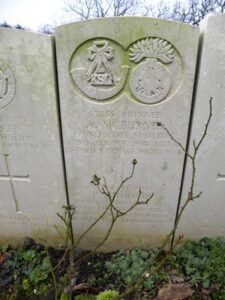
William Southerton, Private, 32923, King’s Shropshire Light Infantry. William was the son of George and Susannah Southerton, of 1, Felton Butler, Montford Bridge, Salop. He enlisted at Shrewsbury into the King’s Shropshire Light Infantry, and after training at Pembroke Dock was posted to their 6th Battalion, which was attached to 60 Brigade, 20th (Light) Division, and moved to France on 22 July 1915. The Division first moved to the Fleurbaix Sector for trench familiarisation and training. When the Battle of Loos was launched on 25 September 1915 the Division fought a diversionary attack towards Fromelles. Later that year they moved north, and fought at the Battle of Mount Sorrel alongside the Canadian Corps. They then fought through the Somme Offensive, at the Battles of Delville Wood, Guillemont, and Flers-Courcelette, Morval and Le Transloy, and took part in the advance to the Hindenburg Line in March, 1917. Later that year they fought at Third Ypres, at the Battles of Langemarck, the Menin Road, and Polygon Wood, William was wounded during the Battle of the Menin Road. He died on 26 September 1917, aged 24, and is buried at Dozinghem Military Cemetery, Belgium.
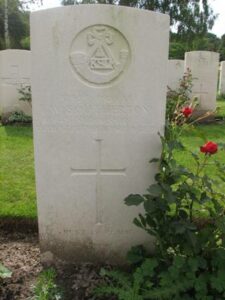
Frederick Stephan, Private, 24064, King’s Shropshire Light Infantry. Frederick was the son of Edward and Annie Stephan, of the Post Office, Coalport, Salop. He had worked as a painter at Madeley and Ironbridge before the war. He enlisted at Ironbridge into the King’s Shropshire Light Infantry, and after training at Pembroke Dock was posted to Salonika, joining the 2nd Battalion, King’s Shropshire Light Infantry, which was attached to 80 Brigade, 27th Division. Frederick was killed in action by a bullet which struck him in the heart during an attack on 31 October 1916, aged 33. He is buried at Mikra British Cemetery, Kalamaria, Greece.
William Stockton, Private, 21311, King’s Shropshire Light Infantry. William was the son of Thomas and Ann Stockton, of Rose Farm, Whixall, Whitchurch, Salop. He enlisted at Wem into the King’s Shropshire Light Infantry, and after training at Pembroke Dock was posted to their 1st Battalion, which had been in France since September 1914, attached to 16 Brigade, 6th Division. Here they took part in the Action of Hooge during June 1915, and in 1916 moved to the Somme, where the Division fought at the Battle of Flers-Courcelette, the Battle of Morval and the Battle of Le Transloy. The following year saw them at Arras, where they fought at the Battle of Hill 70, and then during the Battle of Cambrai later in the year. The Division saw much action during the German Offensives of 1918. William was wounded and captured in March 1918, and died of wounds as a Prisoner of War on 31 March 1918. He was 21 years old, and is buried at Soignies (Zinnik) Communal Cemetery, Belgium.
John Richard Suthon, Private, 33003, King’s Shropshire Light Infantry. John was the only son of George Frederick and Emily Suthon of Chapel Street, Dawley. He enlisted at Wellington into the King’s Shropshire Light Infantry, and after training at Pembroke Dock, was posted to their 10th Battalion, which was in Palestine, attached to 231 Brigade, 74th (Yeomanry) Division. John was killed in action on 30 November 1917, during the operations to take Jerusalem. He is buried at Jerusalem War Cemetery, Israel.
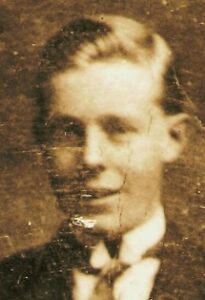
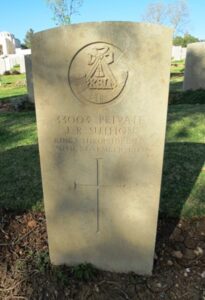
Harold William Symonds, Private, 34452, King’s Shropshire Light Infantry. Harold was the son of George and Eliza Symonds, of The Moors, Walford, Ross-on-Wye. He had enlisted at Hereford into the King’s Shropshire Light Infantry, and trained at Pembroke Dock before being posted to their 1/4th Battalion, which was a Territorial unit that had seen service in the Far East, before returning to France in 1917, where it initially joined 190 Brigade, 63rd (Royal Naval) Division. After fighting at Passchendaele, the battalion transferred to 56 Brigade, 19th (Western) Division, and was decimated by the German offensive on the Lys in April 1918. The battered Division was sent to the Aisne to rebuild, but was hit by a fresh offensive there, with the 1/4th KSLI gaining renown during the defence of Mont de Bligny, the battalion being awarded the French Croix-de-Guerre. Harold was killed on the Aisne on 7 June 1918. He was 21 years old, and is commemorated on the Soissons Memorial, France.
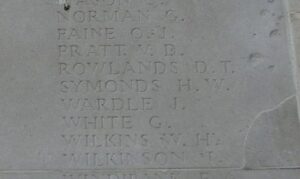
John Taylor, Private, 35670, King’s Shropshire Light Infantry. John was born at Barton, Nottinghamshire, and enlisted at Nottingham into the Army Ordnance Corps, with the number 08137. He was then posted to the King’s Shropshire Light Infantry. After training at Pembroke Dock, he was posted to their 1st Battalion, which was attached to 16 Brigade, 6th Division, which had been in France since 10 September 1914. After participating in most of the major battles of the war, in 1918 the Division took part in the advance in Flanders, before moving to the Somme sector. John was temporarily attached to the Herefordshire Regiment by then, and was killed on 23 July 1917. He is commemorated on Special Memorial A5 at Raperie British Cemetery, Villemontoire, France.
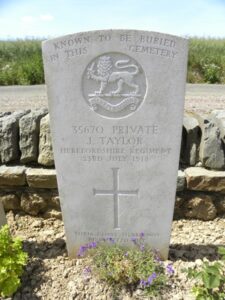
Wallace Thomas Taylor, Sapper, WR/290315, Royal Engineers. Wallace was the son of Richard and Mary Taylor, of 14, St. Michaels Terrace, Shrewsbury, and worked as a Railway Porter at Shrewsbury prior to the war. He originally enlisted into the King’s Shropshire Light Infantry, with the number 25622, and after training at Pembroke Dock was posted to the 24th Welsh Regiment, in Palestine on 20 July 1917. He was then posted again, joining the 96th Light Railway Operating Company, Royal Engineers, and was posted to Ludd in Palestine, where he worked at the Ludd Standard Gauge Railway Depot. Wallace was fast asleep on the morning of 3 August 1918 when several railway wagons became detached, and crashed through the railway buffers into his billet, killing him instantly. He was 20 years old, and is buried at Ramleh War Cemetery, Israel.
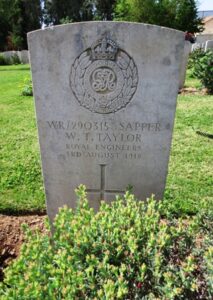
Ernest Thomas, Private, 19378, King’s Shropshire Light Infantry. Ernest was the son of James and Sarah Thomas, of Holstry Turn, Vowchurch, Hereford. He enlisted at Hereford into the King’s Shropshire Light Infantry, and after training at Pembroke Dock was posted to their 6th Battalion, which was attached to 60 Brigade, 20th (Light) Division, and moved to France on 22 July 1915. The Division first moved to the Fleurbaix Sector for trench familiarisation and training. When the Battle of Loos was launched on 25 September 1915 the Division fought a diversionary attack towards Fromelles. Later that year they moved north, and fought at the Battle of Mount Sorrel alongside the Canadian Corps. They then fought through the Somme Offensive, at the Battles of Delville Wood, Guillemont, and Flers-Courcelette. Ernest was killed after the capture of Flers, on 30 August 1916. He was 20 years old, and is commemorated on the Thiepval Memorial, France.
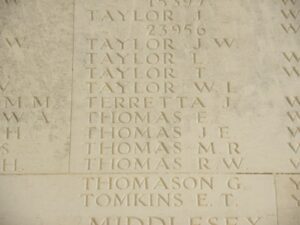
Samuel Thompson, Private, 25305, King’s Shropshire Light Infantry. Samuel was the son of William and Elizabeth Thompson, of Hull, and the husband of Ethel Thompson, of 15, Eileen Grove, Platt Lane, Rusholme, Manchester. He enlisted at Manchester, joining the King’s Shropshire Light Infantry, and after training at Pembroke Dock was posted to their 7th Battalion, which was attached to 76 Brigade, 25th Division. The Division moved to France in September 1915, with the 7th KSLI being transferred to the 3rd Division within weeks of arrival. The battalion saw its first action at the Hohenzollern redoubt, at Loos. In 1916 the Division moved south to the Somme, where they fought during the opening of the Somme Offensive at the Battle of Albert, then at Bazentin, Pozieres, Flers-Courcelette and Morval. It then moved to the Arras Sector for a while, and it was there that Samuel was killed on 1 May 1917. He was 35 years old, and is buried at Windmill British Cemetery, Monchy-Le-Preux, France.
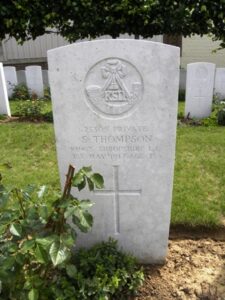
John Robert Tunstall, Private, 18137, King’s Shropshire Light Infantry. John was the son of William Fraser Tunstall and Eliza Catherine Tunstall, of 7, Monkswell Street, Liverpool. He resided at Oswestry prior to the war and enlisted there into the King’s Shropshire Light Infantry. After training at Pembroke Dock he was posted to their 1st Battalion, which was attached to 16 Brigade, 6th Division, which had been in France since 10 September 1914. After participating in most of the major battles of the war, in 1918 the Division took part in the 100 days offensive, which involved the crossing of the St. Quentin Canal. Once the Line had been breached, the Division took part in the Battle of Beaurevoir and the Battle of Cambrai, before the final Pursuit to the Selle and the Battle of the Selle, which is where John was killed on 24 October 1918. He is buried at Cross Roads Cemetery, Fontaine-Au-Bois, France.
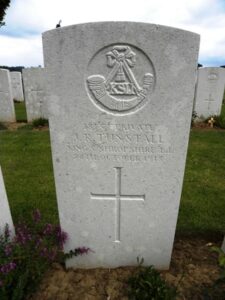
George James Turner, Private, 25053, King’s Shropshire Light Infantry. George was the son of James and Ann Turner, of Kington, Hereford. He worked as a Gardener prior to the war, and resided with his wife Fanny Turner at The Haven, Burghill, Herefordshire. George enlisted at Hereford into the King’s Shropshire Light Infantry, and after training at Pembroke Dock was posted to their 1st Battalion, which was attached to 16 Brigade, 6th Division, which had been in France since 10 September 1914. The Division took part in most of the major battles of the war. In the spring of 1918 the Division was one of those hit by the German Offensive on the Somme, which had been launched on 21 March, and the Division took part in the Battle of St Quentin. George was killed on the second day of the offensive, on 22 March 1918. He was 41 years old, and is commemorated on the Arras Memorial, France.
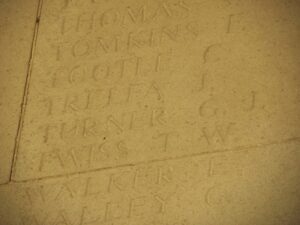
James Thomas Walton, Private, 40346, South Wales Borderers. James was the son of Thomas and Margaret Alice Walton, and the husband of Mary Walton, of 31, Portsmouth Street, Blackburn. He had originally enlisted at Blackburn into the King’s Shropshire Light Infantry, with the service number 32594, but after his training at Pembroke Dock was posted to the 10th Battalion, South Wales Borderers, which was in France attached to 115 Brigade, 38th (Welsh) Division. James survived the war, but died of wounds two months after the Armistice, on 19 January 1919. He was 33 years old, and is buried at Blackburn Cemetery, Lancs.
Walter Warhurst, Private, 126079, Machine Gun Corps. Walter was the son of Harriet Warhurst, of 61, Hall Street, Glossop. He enlisted at Glossop into the King’s Shropshire Light Infantry, with the service number 34658. After training at Pembroke Dock, he was posted to the 6th Battalion, Machine Gun Corps, which was in France attached to the 6th Division. The Division had been in France since December 1914, and had fought in most of the major battles thereafter. During August, 1918 the Allies launched what was to become known as the 100 days offensive, after a brilliant victory at Villers Brettoneux on 8 August. The 6th Division took part in the Advance in Flanders, before moving south, where they took part in the advance on the Hindenburg Line, during the Battle of Epehy, and then at the Battle of the St Quentin Canal. Once the Line had been breached, the Division took part in the Battle of Beaurevoir and the Battle of Cambrai, before the final Pursuit to the Selle and the Battle of the Selle. Walter was killed around this time, on 17 October 1918, aged 23, and is buried at Premont British Cemetery, France.
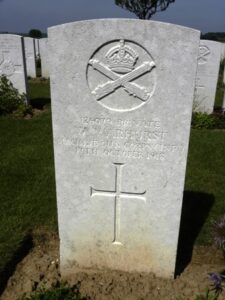
George Henry Williams, Private, 56477, Royal Welsh Fusiliers. George was the husband of Ruth Clara Williams, of 4, Prospect Row, Kington, Herefordshire. He enlisted at Leominster into the King’s Shropshire Light Infantry, with the service number 25631. After training at Pembroke Dock he was posted to the 16th Battalion, Royal Welsh Fusiliers, which was attached to 113 Brigade, 38th (Welsh) Division. George probably joined the Battalion in France late in 1916, after its mauling at Mametz Wood. He moved with the Division to the Canal Bank positions at Boesinghe, north of Ypres, and was killed there during the Battle of Pilckem Ridge on 2 August 1917, aged 32. George has no known grave, and is commemorated on the Ypres (Menin Gate) Memorial, Belgium.
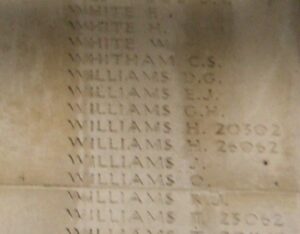
Richard Woodruff, Private, 32523, King’s Shropshire Light Infantry. Richard was born at Blackburn, and enlisted there into the King’s Shropshire Light Infantry. After serving at Pembroke Dock, he was posted to their 10th Battalion, which was attached to 231 Brigade, 74th (Yeomanry) Division, which moved to France from Palestine on 7 May 1918, landing at Marseilles. After a brief period in the line in Flanders, the Division moved to the Somme, and took part in the advance to the Hindenburg Line. Richard was killed in action on 3 September 1918, and is buried at Sailly-Saillisel British Cemetery, France.
